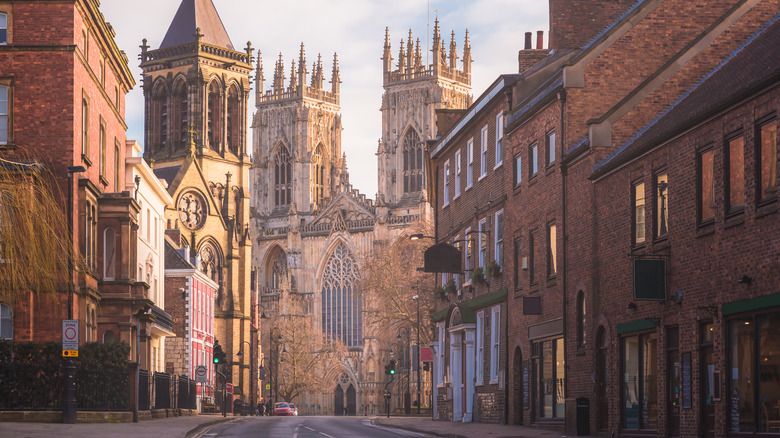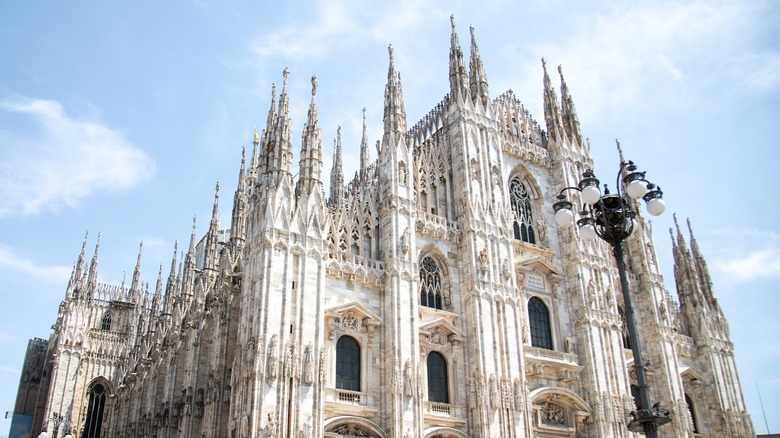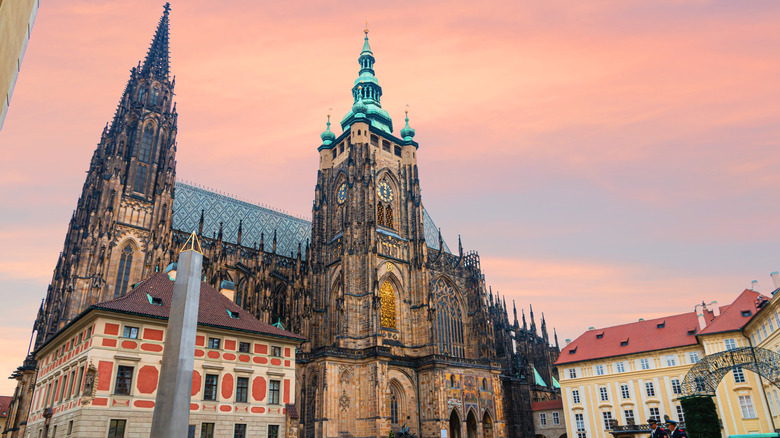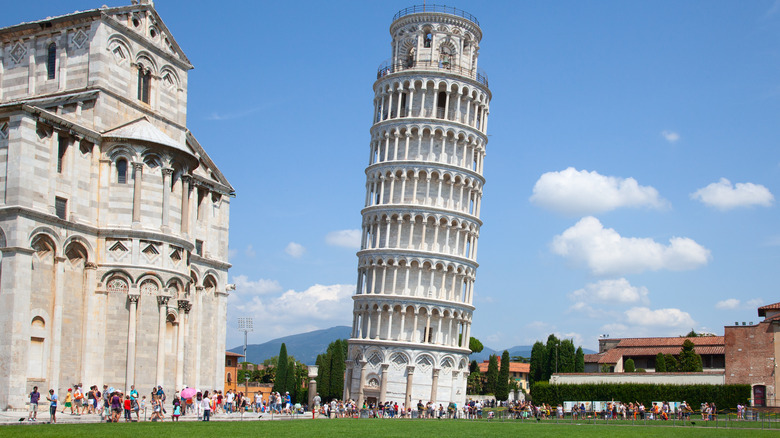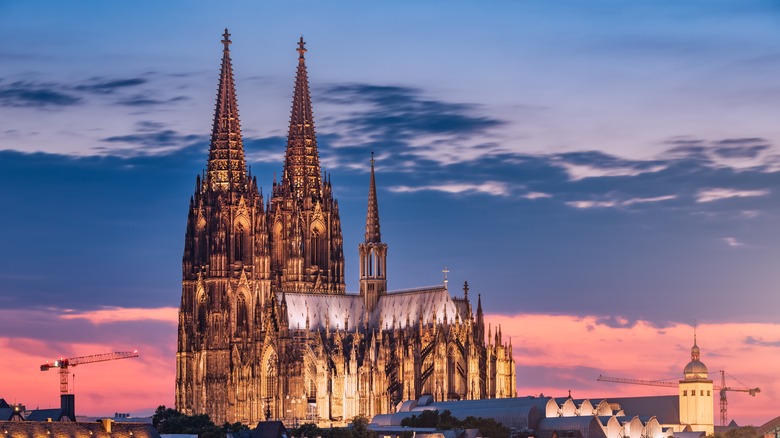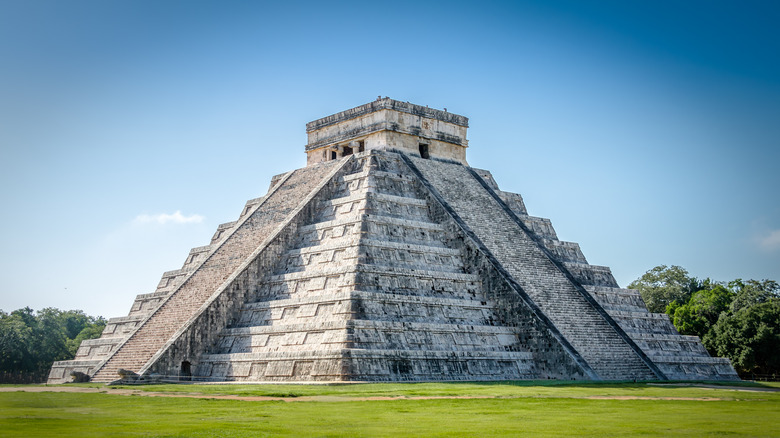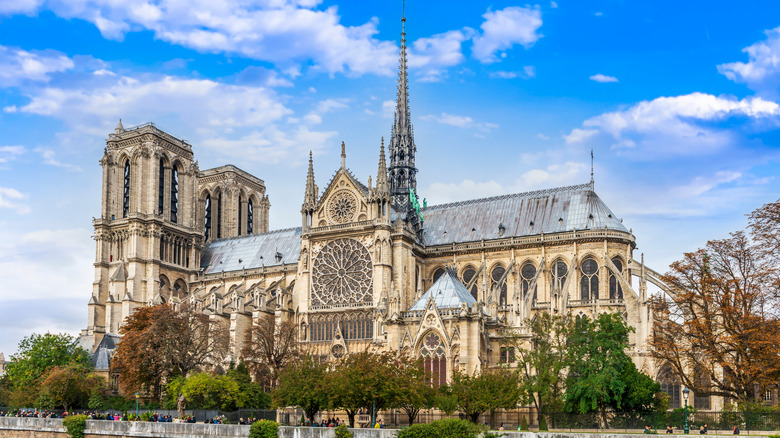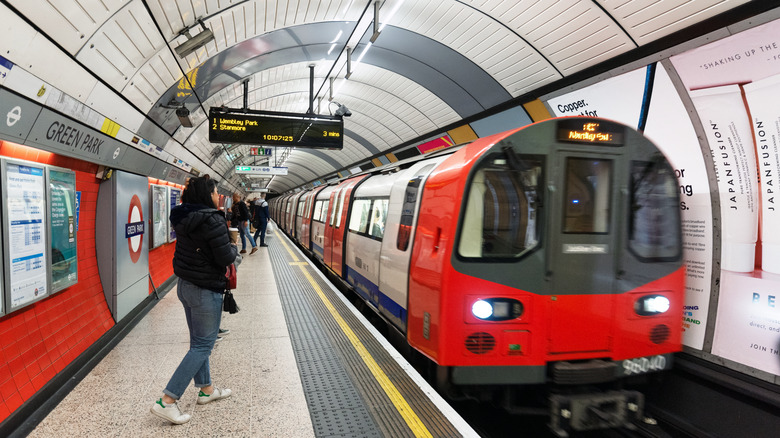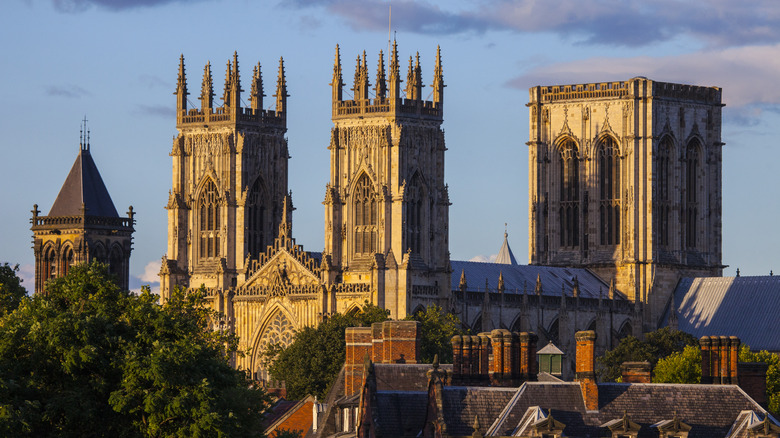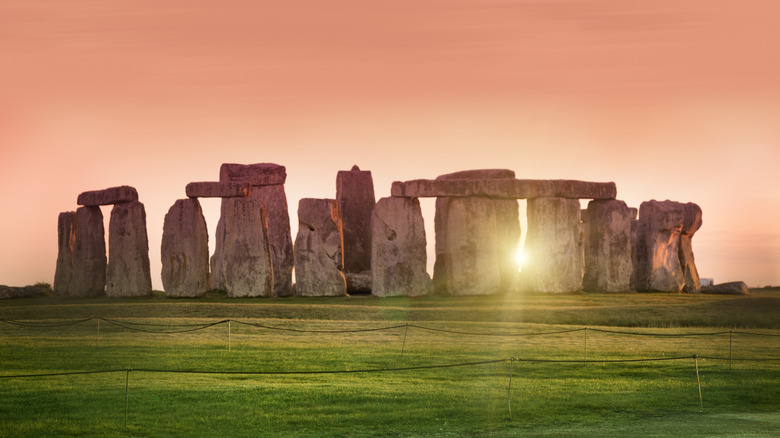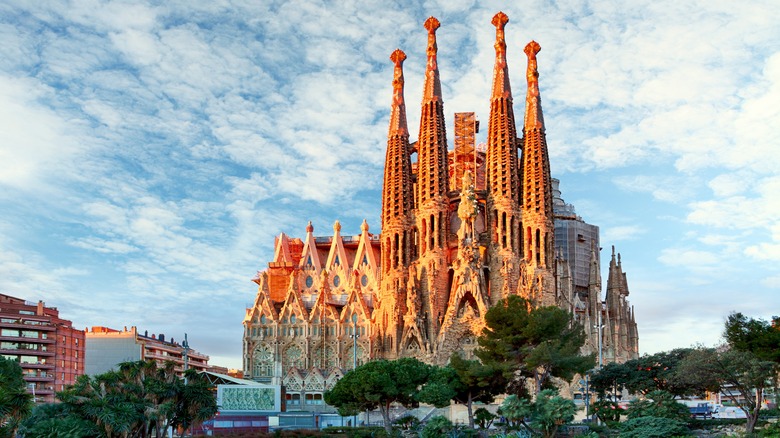Must-See Historic Structures That Took Hundreds Of Years To Build, According To Travelers
Throughout history, humans have built some pretty impressive things. But no matter how big, complex, or unusual, most structures only take a few years or decades to build. For instance, despite the lack of modern technology, the Great Pyramids of Giza were constructed in only 20 to 30 years. From the Taj Mahal to the Palace of Versailles to the Panama Canal, many beloved structures have taken less than a few decades at most to build. But, of course, there are some exceptions.
Some human-built structures have taken not years, not decades, but centuries to build. Some may be lost to time or not open to visitors, but many can be admired or even explored. Using our own experiences as well as reviews from fellow travelers across the World Wide Web, we've come up with a list of magical structures that took hundreds of years to build — and are definitely worth a visit.
Milan Cathedral, Italy
Built between 1386 and 1965, Milan Cathedral's 579-year construction time may seem a bit excessive, but then so is the cathedral itself, with more than 130 marble spires standing out against the skyline like a bold statement of defiance. Milan Cathedral is a feast for the eyes, and when you're in front of it, you may have a hard time deciding what to focus on first: the bas-relief bronze doors, sculptures, or those stunning spires reaching skyward. Inside, the cathedral's lavish visual display continues, with patterned marble flooring, stunning stained glass windows, a gorgeous, gilded crypt, and a space that simply feels massive. Referred to simply as the Duomo (cathedral), the building is the result of centuries of changing architects and architectural styles and choices. It may have taken a long time to finish, but it was worth the wait.
You can buy tickets to visit Milan Cathedral's interior, crypt, and even the archeological remains of the older church that once occupied its spot, but the famous rooftop terraces are probably the best thing to see. You'll get close to the Duomo's amazing architecture and will even be able to stroll among its iconic spires. The cathedral has won plenty of awards, and it isn't difficult to understand why.
Great Wall of China, China
You can't see the Great Wall of China from space, but it's easy to understand why people might believe that. At 13,171 miles long, it's the longest structure ever built by humans. Construction on the Great Wall began sometime in the third century B.C. and finished in the 17th century A.D., a span of nearly 2,000 years. This also makes the Great Wall of China the human-made structure that likely took the longest to build. Like many structures on this list, the Great Wall wasn't built all at once but over a (very long) span of time. This means it features architectural details from different periods of history.
You could spend months hiking the Great Wall or just visit a section for a day. Either way, you'll likely have an incredible experience, as its high rating on numerous tourism sites and constant presence on travel bucket lists attest. There are various ways to access the Great Wall. The most common is a day trip from Beijing to nearby sections like Mutianyu, which can be reached via public transit or tour booking. Other parts of the wall, like the Jiankou section, can be explored for free. These are unrestored sections that involve hiking prowess to reach and climb. Admission prices vary depending on the section of the Wall, and prices are often free or reduced for children under a certain age or height, so research before you go.
St. Vitus Cathedral, Czechia
Built between 1344 and 1929, St. Vitus Cathedral, a part of the Castle Complex in Prague, shows its tumultuous history in its architecture. When construction on the cathedral began, the intention was to build an impressive church in the then-trendy Gothic style. But after about seven decades of construction, the Hussite Wars halted all progress, and in 1541, a fire damaged what had already been built. As the cathedral's slow completion began again, new architects opted to use new stylistic elements since the Gothic style had gone out of fashion. Today, one of St. Vitus's bell towers is in the Gothic style, and the other is Baroque, as per the trends of the 17th century when it was constructed. The cathedral was restored and finally completed by 1929, 585 years after work began.
Even before it was completed, St. Vitus had long been an iconic part of Prague's skyline and the city image. Over the centuries, the cathedral has been the site of coronations and burials of notable historical figures and also houses the remains of saints. Today, visitors to the cathedral praise its beauty, dimensions, and grandeur. Some Tripadvisor reviewers have even called it the most beautiful cathedral they have ever seen. An unfortunate side effect of St. Vitus's appeal is that it is usually crowded. If you want to avoid the crowds, go there early in the morning to limit the wait time to get in.
Leaning Tower of Pisa, Italy
The Leaning Tower of Pisa is actually a bell tower for the beautiful Pisa Cathedral beside it. But it became a legend when, just a few years after its construction began in 1173, it was noticeably leaning due to the unstable soil beneath it. The following two centuries would bring different attempts to straighten the tower and a lengthy struggle to complete it. It was finished in 1372 but has still not been straightened. By the late 20th century, it had to undergo extensive work to keep it standing.
Seeing this iconic tower in person will help you appreciate its charming architectural details, like the arcades surrounding it like lace. Taking a photo where you look like you're propping it up might be a little corny, but it's also fun — and will give you a cool souvenir for years to come. Plus, if you like people-watching, observing other visitors positioning themselves to get their shots makes for a pretty good time.
Visitors aged 8 and older can climb the Leaning Tower of Pisa, but capacity is limited, so reserve in advance. The climb is via a spiral staircase inside the tower, not the external arcade, but there are a few spots to stop and take in the view courtesy of the occasional window, as well as at the top. But the real experience is that you'll actually feel the famous lean, making for a totally unique and unforgettable experience.
Cologne Cathedral, Germany
Some people set aside clothes when they go out of fashion. The city of Cologne, Germany, set aside an entire, incomplete cathedral for centuries. When construction began in 1248, Cologne Cathedral was to be a masterpiece of Gothic architecture, which was all the rage at the time. Because of the church's massive size, it took a long time to build, and by 1560, the town's inhabitants didn't want to contribute money and time to a church that was in a now outdated style. And so, the cathedral was left incomplete until Gothic art became popular again in the 1800s, and construction resumed, finishing at last in 1880 for a total construction time of 632 years.
Today, Cologne Cathedral is a stunning landmark and the third-largest Gothic church in the world, measuring 516 feet tall and 474 feet long. It was named a UNESCO World Heritage site in 1996, and understandably so. Inside and out, it radiates with beauty, making it a must-visit no matter your faith. A visit inside the cathedral is free, but if you want to climb to the top of one of its (very high!) bell towers, you'll have to purchase a ticket.
El Castillo, Mexico
Towering over the ancient Mayan city of Chichén Itzá, El Castillo Pyramid (also called the Temple of Kukulcan) is a marvelous step-pyramid whose interesting architectural details come to life when you see it in person. Unlike many other sites on our list, El Castillo is difficult to date. This is because archeologists have found that it's actually made up of the pyramid we see, plus two others in its interior, one inside the other. The entire structure could have been built and added to from around A.D. 550 (for the inner pyramids) until around A.D. 1300 — a whopping 750 years.
Both a UNESCO World Heritage Site and one of the New Seven Wonders of the World, Chichén Itzá is a fascinating place. The Mayans aligned many of its structures with the sun or other cosmic features. El Castillo itself is also a sort of calendar, with the steps on each of its sides adding up to 365, the number of days of the year. The temple aligns with the sun during the spring and autumn equinoxes so that it looks like the serpent god Quetzalcóatl is slithering down the north steps. It's easy to understand why Tripadvisor reviewers call it "outstanding," "impressive," and "magnificent." Fortunately, there are many options for getting to Chichén Itzá, and the site is a great day trip from Cancùn.
Notre-Dame de Paris, France
Built over 187 years, from 1163 to 1345, Notre-Dame de Paris was one of the first of its kind: A church in the new Gothic style, relying on flying buttresses and other architectural techniques to reduce the amount of stone inside it and let in light, notably through its two enormous, famous rose windows. Over the years, Notre-Dame would occasionally experience changes, notably the removal and replacement of its spire, and it became much more than a building. Whether religious or not, many Parisians consider it a part of the city's soul.
When the cathedral caught fire in 2019, its roof (with its original wooden beams) and its 19th-century spire were both forever lost. Miraculously, the rest of the cathedral survived. People across the globe mourned what was lost and donated money to restore the church. The work has been ongoing since 2019 and is expected to finish in 2024. Whether or not you can go inside Notre-Dame when you visit Paris, seeing it up close is a must. Its façade still rises proudly, and its flying buttresses and tall rear windows are still graceful touches that accentuate the surrounding landscape of lovely buildings, majestic bridges, and the River Seine that flows beside it.
London Underground, England
Some of the most impressive structures built by humans aren't visible at street level. That's the case for the London Underground, whose 250-and-growing miles of tunnels stretch beneath the English capital and its suburbs. Creating an underground transportation system is a complex undertaking, making it even more impressive that the Tube's (as almost everyone calls it) first line was opened all the way back in 1863, after only three years of construction. The Tube is the world's oldest underground public transit system, and since its inauguration, it has been under nearly constant construction in one way or another — new lines being added, new stations being built, and even small details like the Underground's famous map, being created and modified.
No public transportation works perfectly all the time – there will always be delays and unexpected issues. But most visitors to London appreciate the Tube, finding it relatively efficient and easy to use, although it never hurts to peruse a guide or two first. Visitors who want to experience even more of the Tube should consider making a stop at the London Transport Museum, which also organizes Hidden London tours, allowing visitors exclusive access to "behind the scenes" locations in certain stations.
White House, United States
In the long span of history, the United States is a relatively young country, so it may be surprising to see one of its structures on a list of buildings that took centuries to complete. Construction on the White House began in 1792, and in 1800, it was finished, only to be mostly burnt down by the British in 1814. It was rebuilt by original architect James Hoban and finished in 1817. But construction continued over the centuries, including notable additions like the North and South Porticoes. In 1970, the White House, as we know it today, was completed, just 178 years after work began.
Visiting the White House is fairly easy if you only want to see it from outside its gates and take a photo with it in the background, but getting inside for a tour is more complicated. U.S. citizens have to make a request through their Congressional Representative anywhere from 21 to 90 days in advance. The White House's official website doesn't give instructions for non-U.S. citizens who don't reside in the country, but according to this Tripadvisor forum, anyone can contact a member of Congress and try to get a spot on a tour, though it may not be easy due to the number of requests. It's worth trying, though; seeing inside the White House is undoubtedly one of the coolest experiences in Washington, D.C.
York Minster Cathedral, England
The exact date varies depending on the source, but it's generally agreed that construction on York Minster Cathedral began between 1220 and 1230 and finished in 1472. The cathedral's website says that work on York Minster actually began in 1080, which would mean it took 392 years to build, not the usually accepted 250 or so. Regardless of how long it took to build, York Minster is impressive, with its central tower rising over the gorgeous English city of York. At 235 feet, with a length of about 524 feet, this is one of the largest Gothic churches in the world.
In addition to its imposing architecture, York Minster is famous for its stained glass windows, many of which date to the Middle Ages. Some of these are also gigantic. The Great East Window, for instance, is the largest surface area of medieval glass in the entire country. It measures 78 feet tall — the size of a tennis court! But York Minster isn't just about size; its architecture and windows are genuinely beautiful, and if you visit when one of its renowned choirs is singing, that beauty seems accentuated. Visitors leave the Minster impressed and awestruck, a truly breathtaking experience. Most visitors agree that while admission to York Minster is pricey, it's worth the splurge.
Stonehenge, England
Generally agreed to have been constructed between 3000 and 1500 B.C., Stonehenge was constructed in phases over a period of about 1500 years, something archeologists have been able to determine through carbon dating and other techniques. Standing out starkly on Salisbury Plain, Stonehenge's seemingly simple design of one circle of stones surrounding another circle (possibly a semi-circle) conceals a number of curious details. For instance, the inner stones come from a site nearly 200 miles away. How were the generations of Paleolithic builders who created Stonehenge able to transport them? The fact that Stonehenge seems aligned with the sun for the winter and summer solstices seems deliberate, but some archeologists debate this. An even bigger question is what exactly Stonehenge was used for. We may never have the answer to this, but there's something about the monument that still moves us, despite the vast differences in our culture and lives and those of the Neolithic people who built it.
Visitors generally agree that seeing Stonehenge in person is a moving experience. On a more practical level, a nearby recreated Neolithic village and informative displays help bring the site and its time into context. Although the large number of visitors is said to be well-managed by the on-site staff, travelers advise going early, preferably on a cold day (with the exception of the winter solstice), to beat the crowds.
La Sagrada Família, Spain
One evening in 1926, celebrated architect Antoni Gaudí left his Barcelona studio located beside the basilica he'd designed and whose construction he was overseeing, stepped into the street, and was tragically hit by a tram. At the time of Gaudí's death, the Sagrada Família was less than 25% complete. His assistants continued his work, and other architects took it up as the years passed. The Sagrada Família was no small project, and the destruction of many of Gaudí's plans and models during the Spanish Civil War complicated things. Today, nearly a century after Gaudí's death and more than 140 after the start of construction in 1882, the Sagrada Família still isn't finished. Experts hoped it would be completed by the centennial of Gaudí's passing, but the project might have to go on for another few decades.
The Sagrada Família may be a long project, but it's worth it. The church is unique, a thrilling mix of Art Nouveau and Gothic architecture. When you visit it, you're surrounded by the bizarre vegetal forms Gaudí was known for, and your gaze is directed inevitably upward by dramatic lines, a goal of Gothic architecture embraced by this eccentric modern genius. It makes for an otherworldly feeling that everyone should experience. Tickets are pricey for most (although children and seniors can get free or reduced admission), but they'll take you to a breathtaking, weird place unlike any other on Earth.
